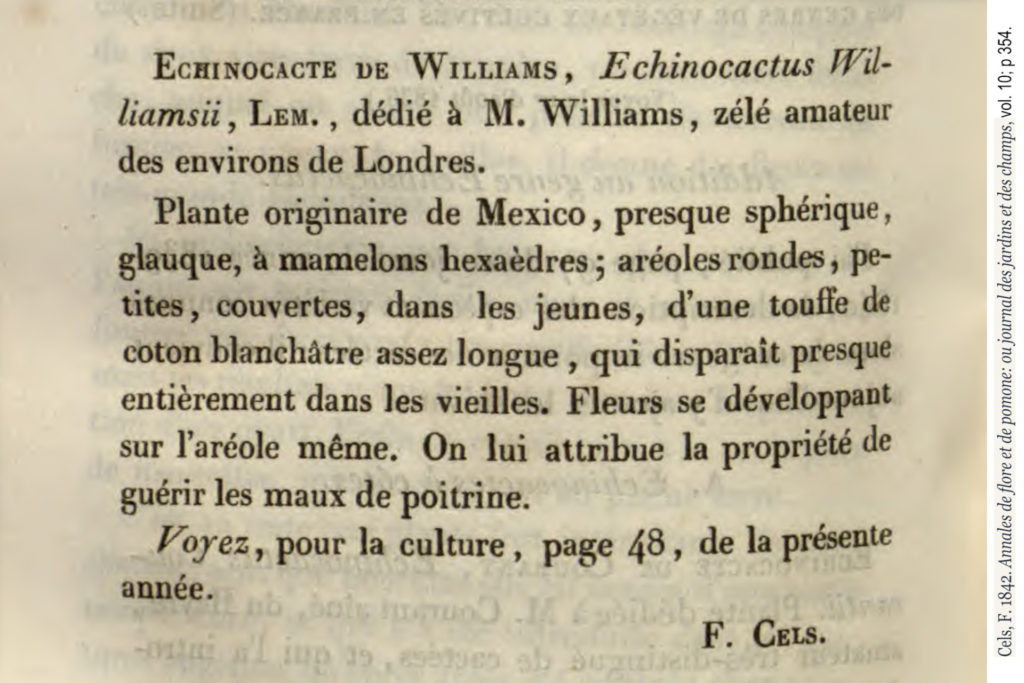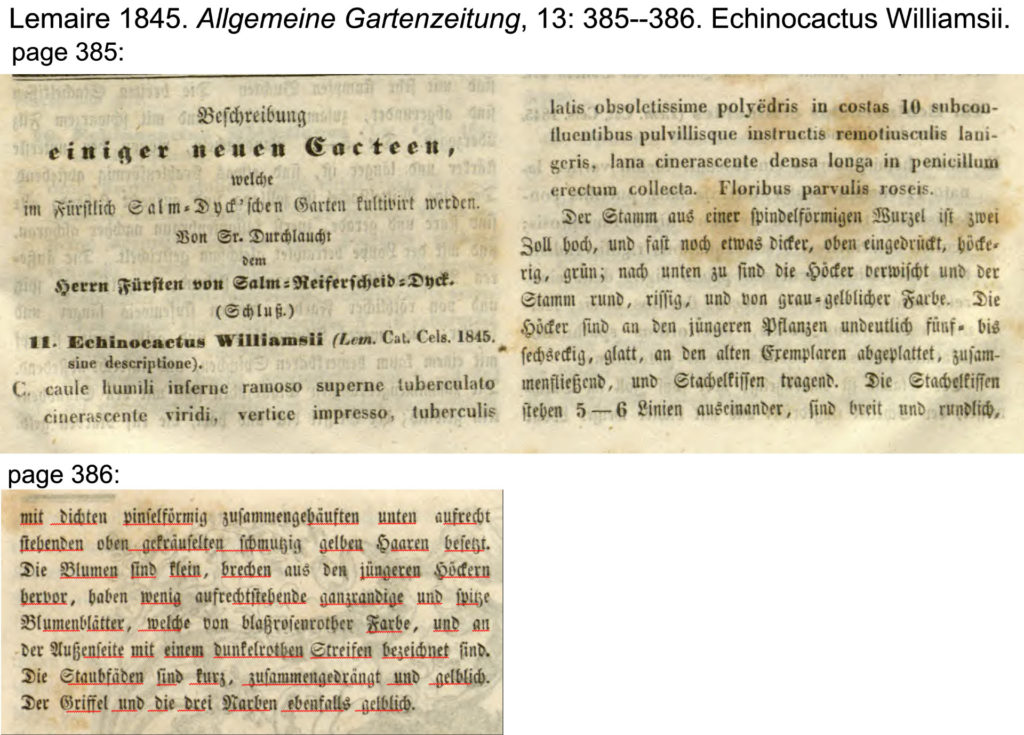

For those with a love of the esoteric: The origins of the naming of Lophophora williamsii
In 1842, François Cels wrote the first known description of Lophophora williamsii. Notably, it lacked a Latin diagnosis but predates Charles Lemaire’s first 1845 description of the species. The Cels document is particularly noteworthy as it stated who the species was named for and also indicated that its homeland was known to be Mexico. Lemaire’s description oddly did not mention either point or Cel’s article, despite making reference to a descriptionless entry appearing on page 28 in the 1845 Cels catalog. Images of both citations are shown in this blog and translations of them appear below.
It is far better known that the choice of the name williamsii was claimed by Theodor Rümpler (in Carl Friedrich Förster 1885) to be in honor of C.H. Williams, who was said to have traveled in Bahia, Brazil. David Hunt 2006 (The New Cactus Lexicon) added that C.H. Williams was a former British ambassador to Bahia, Brazil. The rationale underlying the purported specific name choice was never mentioned by either authority.
It seems more likely, however, that the “Williams” in question may have been the avid cactus collector Rev. Theodore Williams (1785 —1875) who was the vicar of Hendon in North London, as C.H. Williams appears to have lived in Derilys Court, Wales.
Rümpler (1888) had also commented that its country of origin was unknown to him at that time and this was repeated by many later workers.
Citations and Translations:
F. Cels in Auguste Camuzet et al. 1842. Annales de flore et de pomone: ou journal des jardins et des champs (1841-1842), vol. 10; page 354. REVUE Des Genres de Végétaux Cultivés en France (Suite). Addition au genre Echinocactus. B. Echinocactes tuberculeux. Echinocacte de Williams.
B. Echinocactes tuberculeux. Echinocacte de Williams, Echinocactus Williamsii, Lem., dédié à M. Williams, zélé amateur des environs de Londres. Plante originaire de Mexico, presque sphérique, glauque, à mamelons hexaèdres; aréoles rondes, petites, couvertes, dans les jeunes, d’une touffe de coton blanchâtre assez longue, qui disparait Presque entièrement dans les vieilles. Fleurs se développant sur I’aréole
même. On lui attribue la propriété de guérir les maux de poitrine.
William’s Echinocactus, Echinocactus williamsii, Lem., dedicated to Mr. Williams, ardent enthusiast from the London region.
Plant native to Mexico, almost spherical, glaucous, with hexahedral nipples; small round areoles, young plants covered with a fairly long whitish cotton tuft, which disappears almost entirely when older. Flowers develop on the areole itself. It is credited with the property of curing chest pain.
C. Lemaire 1845. Allgemeine Gartenzeitung, 13: 385–386. Echinocactus Williamsii. Echinocactus Williamsii
11. Echinocactus Williamsii (Lem. Cat. Cels. 1845, sine descriptione).
C. caule humili inferne ramoso superne tuberculato cinerascente viridi, vertice impresso, tuberculis latis obsoletissime polyëdris in costas 10 subconfluentibus pulvillisque instructis remotiusculis lanigeris, lana cinerascente densa longa in pencillum erectum
collecta. Floribus parvulis roseis.
Der Stamm aus einer spindelförmigen Wurzel ist zwei Zoll hoch, und fast noch etwas dicker, oben eingedrückt höckerig, grün; nach unten zu sind die höcker verwischt und der Stamm rund, rissig, und von grau-gelbischer Farbe. Die Höcker sind an den jungeren Pflanzen undeutlich fünf bis sechseckig, glatt, an den alten Exemplaren abgeplattet, zusammenflieszend, und Stachelkissen tragend. Die Stachelkissen stehen 5–6 Linien* auseinander, sind breit und rundlich, mit dichten pinselförmig zusammengehäuften unten aufrecht stehenden oben gekräuselten schmutzig gelben haaren besetzt. Die Blumen sind klein, brechen aus den jüngeren höckern hervor, haben wenig ausrechtstehende ganzrandige und spitze Blumenblätter, welche von blaßrosenrother Farbe, und an der Auszenseite mit einem dunkelrothen Streifen bezeichnet sind. Die Staubfäden sind kurz, zusammengedrängt und gelblich. Der Griffel und die drei Narben ebenfalls gelblich.
The stem of a spindle-shaped root is two inches high, and almost a little thicker, the crown is depressed and tuberculate, green; lower on the tubercles becoming indistinct and the trunk is round, cracked, and of gray-yellowish color. The tubercles on the younger plants are indistinctly five- to six-angled, smooth, flattened on the old specimens, flowing together, and bearing spiked areoles. The spiked areoles are 5–6 Lines* apart, are broad and roundish, with dense brush-shaped, downwardly-curled, crinkled, dirty-yellow hairs. The flowers are small, borne out of the youngest areoles, having small, entire-margined and pointed petals, of a pale rose-red color, and
marked on the outside with a dark red stripe. The stamens are short, compressed and yellowish. The stylus and the three stigma lobes also yellowish.
* Linien AKA Lines is an archaic unit of measurement that in this particular application was = 1/10”. It was never made an official unit of measurement as there were several different units of length using this same name.
